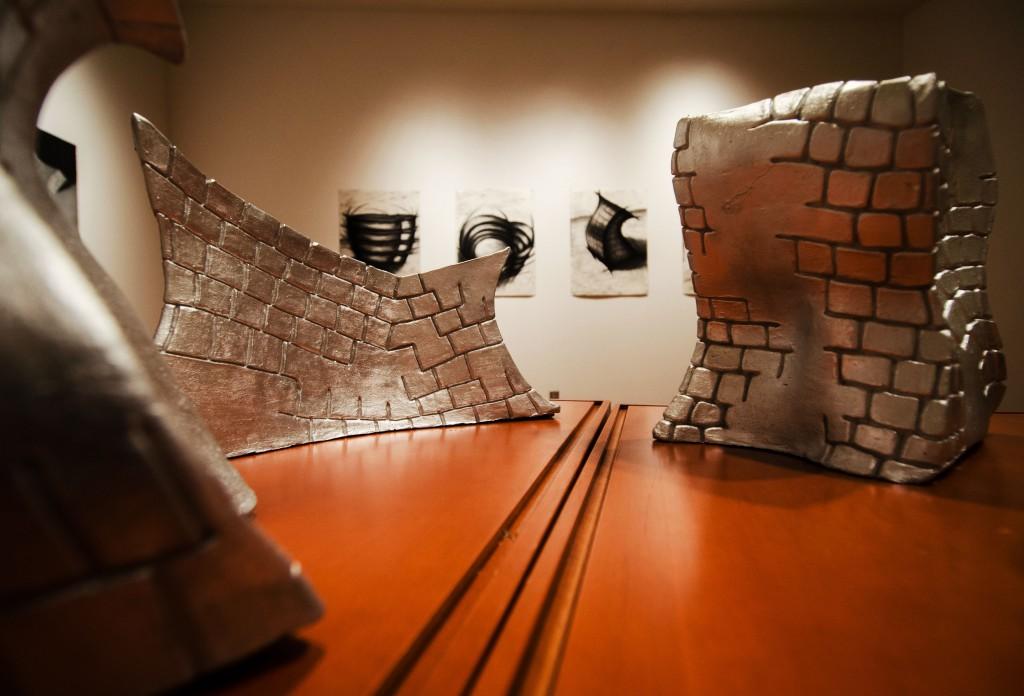By Christopher Squier
squierch@grinnell.edu
Miniature, squirming structures vibrating with techno energy are captured in mid-dance move. Glittering, biomorphic and rectilinear disco balls lean towards one another, like Macbeth’s witches in the midst of a séance. An isolated and futuristic monolith is shrunk to a tiny portion of its original size, leaning precariously farther and farther outward. Since the newspapers covering the windows came down Tuesday afternoon, this is how senior Diana Ossa’s Smith Gallery show Art & Architecture: Guggenheim appears.

Science fiction scenes of widespread metropolises, rockets, the glimmering sheen of space suits and imagined technological futures—all find their niche in Ossa’s work. The walls are hung with strange architectural shapes, drawn in charcoal and chalk. Three of these are drawn with a soft and surreal expression, placing the buildings in dreamlike voids with flat grounds and black nights. The other four drawings are sketchier, with lines jutting from the edges of the buildings. Full of motion and energy, they resemble conceptual plans for strange, thin and bulging buildings.
At the south of the room, five clay sculptures stand in miniature on a number of chestnut pedestals. Four of these share liveliness in their organic curves and flat gloss of silver spray paint. Their surfaces are carved with crevices in brick or stone patterns that dissolve effortlessly away into the smoothness of the clay.
These four are ceramic derivatives of the Guggenheim Museum Bilbao, a globally renowned art locale covered in a curvilinear, wavelike series of titanium rectangles. Although based off of Frank Gehry’s famous architecture, Ossa’s ceramic sculptures reinterpret the building, shattering it into a fractured shrapnel of its more massive self.
Ossa effectively deconstructs the showy structure and reinstates it as a number of more modest and expressive parts.
The fifth sculpture occupies its own pedestal, standing four tiers tall. This piece represents the spiraling Frank Lloyd Wright Guggenheim located in Manhattan, New York.
“I chose two architects who I’m inspired by and then I used their work and transformed it into my own art,” Ossa said.
Combined, the choice of these two museums show the degree to which the museum has been aestheticized, to the point that Ossa can draw from them in making works of art of her own.
“Basically, with both of them, what I tried to do was to make my own representation of how I see the building,” Ossa said. “For the Guggenheim in New York, I thought one of the major things is how the building doesn’t have any stairs, but it has a ramp that goes up. That’s the way the visitors can see all the artwork. The main thing I was interested in with this artwork was people being able to see inside of it.”
Ossa is interested in the ways that architecture can be approached from a visual perspective, rather than that of a strictly structural or engineering one.
“Since I was in high school, I always wanted to study architecture, but I always wanted to do it from an art perspective,” Ossa said.
As Ossa finishes up her final year as a studio art major, she is transitioning to graduate school in architecture at the University of Washington in Saint Louis.
“The purpose of this project was to link something that I’m really passionate about that’s coming to an end with something that’s at its start,” Ossa said.
In the case of the Guggenheim in Manhattan, Ossa cited Frank Lloyd Wright’s inspiration in architectural design.
“One of the things that Frank Lloyd Wright said was that he wanted to create an architectural space that was just as beautiful as the work inside,” Ossa said. “For him, that was his work of art. That’s the way I see architecture in some ways. I’m not going to be drawing or doing clay, but in some ways, [architecture] is still going to be my art.”
Throughout Art & Architecture, this parallel is apparent. Museums are made into artwork and, in the process, outshine the relatively mundane space of the Smith Gallery. Although the show is sparse and the sculptures are on the smaller side, Ossa’s art becomes the clear star of the show.
The variety of media in which Ossa’s works give her structures double the poignancy, exploring different aspects of their visual qualities. Ossa’s ceramics emphasize the architectural surfaces and show how the building can be experiences from different perspectives, while her charcoals abstract and emphasize the structural lines and curving surfaces. Ossa gives us a fascinating look at architecture through her eyes, which is well worth considering.


































































